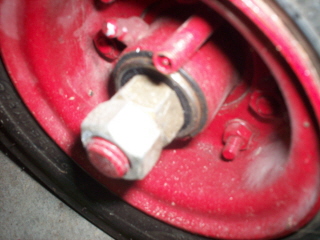The go karter builder had just finished putting the final touches on his go cart and was all excited about going for a test drive. He go it out of the shed and took for a spin around the drive way. Suddenly the front wheels started acting up.
The driver’s side (or left side) wheel suddenly became wobbly and almost fell off, and at the same time the passenger’s side wheel suddenly locked up and caused the go kart to vere off to the right and stop suddenly.
What happened here that both things happened at the same time?!
What we have is a case of fastener woes, or fastener assumption that made the go kart builder assume most incorrectly that he had the wheels fastened correctly.
We all know how a bolt uses he right had rule “Righty Tighty…Lefty Loosey.” (Or Clock Wise Tighten, Counter Clock Wise Loosen.)
We also don’t give much thought to which direction the tires are turning when the go kart is running. When you look at the driver’s side of the go kart (or the left side) which direction are the wheels spinning? Counter Clock Wise….or they are tending to loosen the main nut that holds the go kart wheels on their main axels. As a result the natural tendancy of the wheel while spinning is to loosen the nut. And that is just what happened to the go karter in this story.
What about the other side? What is happening on the passenger side (or the right side)? The wheels are spinning clock wise, or the natural tendancy is for the wheel to tighten the bolt. The tightening the bolt can actually have drastic consequences which can damage the wheels and the bearings. More often that not we are rudely awaken to the tightening wheel and then realize there is more going on here than meets the eye.
The clamping action of the tightening nut will sqeeze he bearings down to the hub of the wheel. This will cause the wheel to slow down drastically. But if the bearings are low cost and the rims are on a lighter go kart, the action of clamping can be so severe as to smash or bole right through the bearing and cause the hub and bearing to be destroyed.
There is an answer to this “loosening” and “tightening” problem…and it is not lock nuts. Nylon lock nuts have their place, but more often than not, they DO NOT work well in holding wheels in place because the nylock can get oil soaked or relaxed causing the nut to actually be loose and not fixed in position. The nylocks intention is to make a fixed position hold…but the torque loads that result from cornering and plain driving are more than the nylock can offer.

Double Jam Nut Retention Method
So the best and surest method is to use the nut-to-nut jam method. What you do is take a plain simple nut and snug it into position to hold the wheel on. Loosen the nut slightly so the wheel spins freely. Then take a second nut and tighten it down on the first. The key is to take two wrenches, one on the front nut, one on the back nut. Hold the back nut so it cannot , I repeat…CAN NOT tighten or move and then tighten the front nut down hard so that the two nuts are jammed together. The unit of the two nuts jammed together makes a firm grip that cannot be moved.
In case you are thinking this is a hokey method, this is what has been used for years and years…in fact it was the precursor to the nylock nut. Bicycles use similar methods to hold cranks and steering column bearings in position so that they do not lock up either.
If you would like more information about go kart building be sure to visit the How To Build a Go Kart series. If you would like to build a go kart for under $50 consider the wood go kart which uses every day stuff to make a head turning, tire burning go kart.



Thanks Bob – great article. Been having this problem of the wheel loosening
up on the back drive side wheel.
Not sure I have enough thread to get another nut fully on there but
hopefully should be close.
Best,
Jamie
The other method, is to use a cross drilled hole on the shaft and then pinning it. Be sure to put a washer between the pin and the spinning wheel. If you do not, then the pin will become sheared off and then you will have the wheel falling of anyway! Grease is needed for this method, but it works too.
Also, you can use a castle nut which is the same thing accept the nut has slots in it so the cotter pin can be slid in it to prevent the nut from spinning out. This is the method used on cars especially the front discs on rear wheel drive vehicles.
What about locking collars?
Locking collars are in my opinion only useful as spacers. The “locking” feature is not as reliable as a cross bolt, because typically the locking feature is a set screw which can become undone with vibration.
I’m having the same issue. I’m wondering, should there be a washer between my wheel and the nut and/or spacer on the inside? I currently don’t use a washer and I’m wodering if that is part of the reason my wheels and bearings keep popping off
The wheel bearing and the holding nut should be isolated from eachother. The turning friction of the bearing will be transmitted into the washer, however that is not enough. The doubled up nut is vital, either that or a castle nut, with a cotter pin going across it.